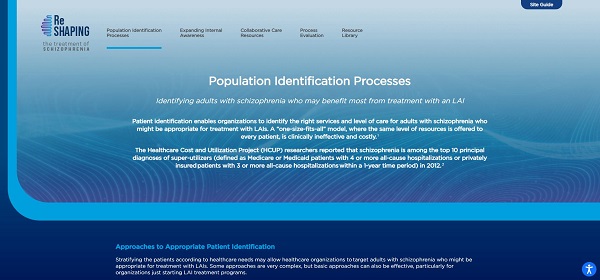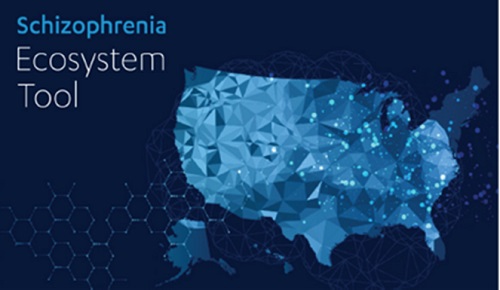The Schizophrenia Ecosystem Tool (SET), a first of its kind, and the Reshaping the Treatment of Schizophrenia in Adults website are 2 new resources developed by Janssen that will enhance a comprehensive approach to educating on schizophrenia and long-acting injectables for population health decision makers and payers.
Informed by conversation with Jennifer Thomas: Director of Marketing, Schizophrenia, and Jack Sheehan: Senior Director, Value and Evidence
Sponsored By Janssen Neuroscience
About 2.8 million adults in the United States are living with schizophrenia, a mental health condition that affects everything from how someone thinks to how they feel and behave.1,2 A comprehensive treatment plan can be very important to an individual’s recovery journey, resiliency, and well-being and may include therapy, medication, and support services. Research has found a link between low adherence to schizophrenia treatment and schizophrenia symptom relapse, which can interrupt every aspect of an adult patient’s life, often resulting in cycles of crisis that can impact personal relationships, health, financial well-being, and more. On average, adult patients with schizophrenia have an average of 9 relapse episodes in about 5.5 years.3
Studies have shown that adults living with schizophrenia who have more relapse episodes have more hospitalizations, which can lead to significantly higher medical costs for patients, hospital systems, and payers.4,5,6 Treatment options, like long-acting injectable (LAI) antipsychotics, that are professionally administered and can therefore help to identify medication nonadherence and delay time to relapse can contribute to lower healthcare resource utilization and cost as patients are less often hospitalized when their schizophrenia symptoms are effectively managed.4,5,6
“Providing longer term treatment options for adults living with schizophrenia has the potential to help identify medication nonadherence since it is a professionally administered medication and may delay time to relapse,” Jennifer Thomas, Director of Marketing, Schizophrenia, said. “Medication is one part of the whole treatment plan to help keep schizophrenia symptoms controlled, in addition to counseling and self-care. It is important for adults living with schizophrenia to talk to their healthcare provider to find the right treatment plan for them.”
According to the 2020 American Psychiatric Association Practice Guideline for the Treatment of Patients With Schizophrenia, LAI medications provide greater assurance that a patient will receive medication continuously, because they are professionally administered and there are fewer opportunities to miss a medication dose.
Jack Sheehan, Senior Director, Value and Evidence, stated, “Although there is evidence pointing to benefits of LAIs, the use of LAIs has largely been reserved for adults with schizophrenia who have trouble with adherence to schizophrenia medication, in part due to previous guidelines. Medical associations like the National Council on Mental Wellbeing, however, have recently updated their guidelines to recommend LAIs for adult patients diagnosed with schizophrenia earlier in their treatment journey.” LAIs remain largely underutilized and, according to some studies, only 13%-22% of eligible patients with schizophrenia in the United States receive them.7
LAIs offer a number of potential advantages compared to oral medication for schizophrenia: relief from the burden of taking schizophrenia medication every day, improved healthcare resource utilization, and delayed time to relapse.8 Initiation of LAIs vs. orals antipsychotics may provide considerable benefit to patient outcome and potentially reduce the burden on healthcare resources.6
The Schizophrenia Ecosystem Tool (SET) and the Reshaping the Treatment of Schizophrenia in Adults website are 2 new resources developed by Janssen that will enhance a comprehensive approach to educating on schizophrenia and LAIs for population health decision makers (PHDMs) and payers. SET offers the ability to identify the unmet need in schizophrenia and is an interactive map that is used to visualize the burden of schizophrenia in adults in the United States.
“Healthcare systems are shifting toward delivering improved outcomes, enhancing the patient experience, and providing value-based care. At Janssen, we have applied insights from real-world evidence to be able to develop promising tools such as the Schizophrenia Ecosystem Tool (SET) to deliver educational resources that provide value to patients, healthcare professionals, and healthcare systems,” said Jennifer Thomas. The development of SET followed a process that involved identifying key metrics, acquiring data, and creating an interactive tool for visualizing the information. The tool is divided into 6 main categories, including antipsychotic utilization, healthcare resource utilization, quality measures, cost of care, policies, and social determinants of health. These categories are further drilled down into subcategories that help illustrate the need at state, and local levels. The end user can choose the measure of interest and visualize it at the national, state and local levels.* They can also visualize 2 measures of interest simultaneously. Despite the tremendous burden of the disease, no tool like this has ever been developed for schizophrenia.

SET can help identify region-specific areas of need for greater resource allocation as well as patient groups who are currently underserved. “These key insights from SET can be used to inform mental health service planning and provision, and in turn help to mitigate the burden associated with schizophrenia for both the adult patients and the healthcare system,” said Jack Sheehan. “For example, a local PHDM can identify gaps in outcomes among patients with schizophrenia in their region. They can then compare treatment patterns and policies in the region compared with other regions to pinpoint the likely causes of the gap in outcome. Closing these gaps offers the potential of improved outcomes for patients with schizophrenia.” Additionally, the Reshaping the Treatment of Schizophrenia in Adults website can offer PHDMs ideas for how to close gaps in outcomes identified in SET, by providing the ability to initiate and maintain patient-tailored approaches to schizophrenia treatment.

The Reshaping the Treatment of Schizophrenia in Adults website is an informative tool for PHDMs who want to reevaluate their schizophrenia treatment strategy, which may include earlier adoption of LAIs for adult patients with schizophrenia. The website offers educational resources to support PHDMs and treatment team members who believe in the value of appropriate use of LAIs for adult patients with schizophrenia and could use support in efforts for a coordinated approach to care. The website is divided into 4 sections: Population Identification Processes, Expanding Internal Awareness, Collaborative Care Resources, and Process Evaluation. Each of these addresses activities that can be part of a system process to encourage appropriate and earlier LAI use and includes educational resources and tools that are intended for use by the institution as well as resources that can be used with patients and caregivers. PHDMs and treatment team members will be able to implement these resources in their care strategies to help improve patient outcomes and healthcare resource utilization.
Whereas SET is a tool to increase awareness and education of the burden of schizophrenia and the impact of social determinants of health, as well as helping to raise the urgency to shift from an oral-centric paradigm to LAIs, the Reshaping the Treatment of Schizophrenia in Adults website is an external website that provides educational resources and information for PHDMs, including payers, healthcare system leaders, and treatment team members, who want to implement a change in their treatment strategy for adults living with schizophrenia, including earlier adoption of LAIs. Jennifer Thomas said, “By educating both internal and external stakeholders through key insights pulled from local and regional real-world data, stakeholders can come together to fill knowledge gaps and support better patient and societal outcomes.”
*Local level data is only available for antipsychotic utilization, quality measures, costs of care, and healthcare resource utilization.
About The Experts
Jennifer Thomas is the Director of Marketing, Schizophrenia Portfolio at The Janssen Pharmaceutical Companies of Johnson & Johnson. Jennifer oversees the strategic development and execution of marketing activities for the Janssen long-acting injectable portfolio of schizophrenia medicines.
Jack Sheehan is the Senior Director Value and Evidence (HEOR) Neuroscience at Janssen ScientificAffairs, LLC. In his role, Jack leads real-world value and evidence research to understand the burden of illness and effective ways to address illness among adults with neurologic and psychiatric conditions.
References:
1 Regier, D. A., Narrow, W. E., Rae, D. S., Manderscheid, R. W., Locke, B. Z., & Goodwin, F. K. (1993). The de facto US mental and addictive disorders service system. Epidemiologic catchment area prospective 1-year prevalence rates of disorders and services. Archives of general psychiatry, 50(2), 85–94. https://doi.org/10.1001/archpsyc.1993.01820140007001
2 U.S. Census Bureau. Quick Facts. Retrieved from: https://www.census.gov/quickfacts/fact/table/US/PST045219
3 Lafeuille MH, Gravel J, Lefebvre P, et al. Patterns of relapse and associated cost burden in schizophrenia patients receiving atypical antipsychotics. J Med Econ. 2013;16(11):1290-1299. doi:10.3111/13696998.2013.841705
4 Fu, A.Z., Pesa, J., Lakey, S., Benson, C. (2022). Healthcare resource utilization and costs before and after long-acting injectable antipsychotic initiation in commercially insured young adults with schizophrenia. BMC Psychiatry 22 (250). https://doi.org/10.1186/s12888-022-03895-2
5 National Council for Mental Wellbeing. Guide to Long-Acting Medications. National Council for Mental Wellbeing website. Accessed July 21, 2021. Available at: https://www.thenationalcouncil.org/topics/long-acting-medications/
6 Morken G, Widen JH, Grawe RW. Non-adherence to antipsychotic medication, relapse and rehospitalisation in recent-onset schizophrenia. BMC Psychiatry. 2008;8(32). doi:10.1186/1471-244X-8-32
7 Sajatovic, M., Ross, R., Legacy, S. N., Byerly, M., Kane, J. M., DiBiasi, F., Fitzgerald, H., & Correll, C. U. (2018). Initiating/maintaining long-acting injectable antipsychotics in schizophrenia/schizoaffective or bipolar disorder – expert consensus survey part 2. Neuropsychiatric Disease and Treatment, 14, 1475–1492. https://doi.org/10.2147/NDT.S167485
8 Brissos S, Veguilla MR, Taylor D, et al. The role of long-acting injectable antipsychotics in schizophrenia: a critical appraisal. Ther Adv Pyschopharmacol. 2014;4(5):198-219. doi:10.1177/2045125314540297
9 Offord S, Wong B., Mirski D., Baker R., Lin J. (2013) Healthcare resource usage of schizophrenia patients initiating long-acting injectable antipsychotics vs oral. J Med Econ 16: 231–239



















